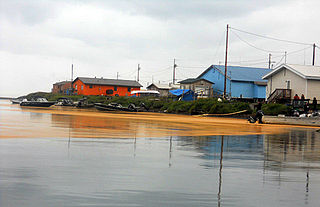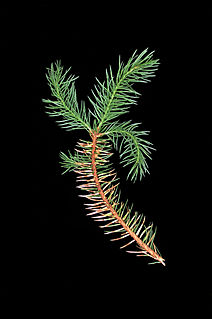
Taiga, generally referred to in North America as boreal forest or snow forest, is a biome characterized by coniferous forests consisting mostly of pines, spruces, and larches.

A spruce is a tree of the genus Picea, a genus of about 35 species of coniferous evergreen trees in the family Pinaceae, found in the northern temperate and boreal (taiga) regions of the Earth. Picea is the sole genus in the subfamily Piceoideae. Spruces are large trees, from about 20–60 m tall when mature, and have whorled branches and conical form. They can be distinguished from other members of the pine family by their needles (leaves), which are four-sided and attached singly to small persistent peg-like structures on the branches, and by their cones, which hang downwards after they are pollinated. The needles are shed when 4–10 years old, leaving the branches rough with the retained pegs. In other similar genera, the branches are fairly smooth.

Picea abies, the Norway spruce or European spruce, is a species of spruce native to Northern, Central and Eastern Europe. It has branchlets that typically hang downwards, and the largest cones of any spruce, 9–17 cm long. It is very closely related to the Siberian spruce, which replaces it east of the Ural Mountains, and with which it hybridises freely. The Norway spruce is widely planted for its wood, and is the species used as the main Christmas tree in several countries around the world. It was the first gymnosperm to have its genome sequenced. The Latin specific epithet abies means “fir-like”.

Picea sitchensis, the Sitka spruce, is a large, coniferous, evergreen tree growing to almost 100 m (330 ft) tall, with a trunk diameter at breast height that can exceed 5 m (16 ft). It is by far the largest species of spruce and the fifth-largest conifer in the world ; and the third-tallest conifer species. The Sitka spruce is one of the few species documented to exceed 300 ft (90 m) in height. Its name is derived from the community of Sitka in southeast Alaska, where it is prevalent. Its range hugs the western coast of Canada and the US, continuing south into northernmost California.

Spruce beer is a beverage flavored with the buds, needles, or essence of spruce trees. Spruce beer can refer to either alcoholic or non-alcoholic beverages.

Ledi Sayadaw U Ñaṇadhaja was an influential Theravada Buddhist monk. He was recognized from a young age as being developed in both the theory (Abhidharma) and practice of Buddhism and so was revered as being scholarly. He wrote many books on Dhamma in Burmese and these were accessible even to a serious lay person, hence he was responsible for spreading Dhamma to all levels of society and reviving the traditional practice of vipassana meditation, making it more available for renunciates and lay people alike.

Chrysomyxa ledi var. rhododendri is a plant pathogen responsible for the disease spruce needle rust.

Coleophora ledi is a moth of the family Coleophoridae. It is found from Fennoscandia and northern Russia to the Pyrenees and the Alps. In the east, it ranges to Japan. Outside of Eurasia, it is known from North America where it is found in eastern Canada, Michigan, and Alaska.

Chrysomyxa is a genus of rust fungi in the family Coleosporiaceae. The genus, widespread in the Northern Hemisphere, contains about 23 species. Rust fungi in the genus Chrysomyxa occur in boreal forests of the northern hemisphere on Pinaceae,, and most species alternate to angiosperm hosts in the Ericaceae.

Chrysomyxa ledicola is a plant pathogen responsible for the disease large-spored spruce-Labrador tea rust. It affects white spruce, black spruce, Sitka spruce, Englemann spruce, and Labrador-tea. It is also the cause of the orange goo that covered the Iñupiat village of Kivalina, Alaska in the summer of 2011.
Chrysomyxa abietis, or spruce needle rust, is a species of rust fungi in the Coleosporiaceae family that is native to eastern Europe and northern Asia. It was introduced to Australia, New Zealand and the United States.
Chrysomyxa himalensis, is a species of rust fungi in the Coleosporiaceae family that can be found on Rhododendron and Picea species in the Himalayan region of southern Asia and was introduced in the United States.
Spruce broom rust or yellow witches' broom rust is a fungal plant disease caused by the basidiomycete fungus known as Chrysomyxa arctostaphyli. It occurs exclusively in North America, with the most concentrated outbreaks occurring in northern Arizona and southern Colorado on blue and Engelmann spruce, as well as in Alaska on black and white spruce. This disease alternates its life cycle between two hosts, with the spruce serving as the primary host and bearberry serving as the secondary or alternate host. The name for the disease comes from the distinctive “witches broom”, commonly yellow in color, which forms on the spruce after young needles have been infected. Management must be carried out through physical or mechanical methods, such as the pruning of brooms or the removal of the secondary host from the area, because no chemical control measures have yet been determined to be economically effective. Generally, spruce broom rust is seen as a mostly cosmetic issue, and it is very rarely the direct cause of tree death; however, research has shown a reduction in overall productivity and health of infected trees, making it an important issue for logging and timber companies.

Chrysomyxa weirii, is a fungus that causes a disease, commonly known as Weir's cushion rust, of spruce trees. It is mostly a cosmetic problem, causing yellowish spotting and banding on spruce needles, but in some cases can cause severe premature defoliation. Weir’s cushion rust can also disfigure and reduce growth of spruce trees by targeting the tender needles of newly emerging shoots. This pathogen's spores are spread by wind and water splash and germinate to infect newly developing needles on the same spruce, or neighboring spruce trees. Unlike many other rust disease pathogens, C. weirii is autoecious, only infecting spruce trees. C. weirii is also microcyclic, producing only two of the five possible spore stages common in rust fungi. Trees affected by Weir's cushion rust usually have obvious symptoms, but if treated correctly, the disease can be managed.
Chrysomyxa cassandrae is a fungus that occurs throughout the North Temperate Zone wherever Chamaedaphne calyculata occurs, independent of host alternation. Aecial hosts include white spruce.
Chrysomyxa nagodhii is a species of rust fungus in the family Coleosporiaceae. It was described as new to science by Canadian mycologist Patricia E. Crane in 2001. It probably occurs throughout the range of Ledum decumbens and Rhododendron groenlandicum. On Picea, spermogonia and aecia occur on distinct rusty yellow bands on current-year needles.
Chrysomyxa neoglandulosi probably occurs wherever its telial host Ledum glandulosum Nutt. is found. The only reported aecial host, Engelmann spruce, occurs in montane to subalpine areas in western Canada and the United States.
Chrysomyxa reticulata has been found on Ledum decumbens and Ledum groenlandicum in both eastern and western Canada, as well as Wisconsin, Washington, and California, in the United States, but the aecia are so far known only from artificial inoculation of white spruce.
The spruce cone rust, caused by the rust fungus Chrysomyxa pirolata Wint., affects spruces in 3 continents, including white spruce in Canada. Alternate hosts of the fungus are several species among 3 genera of wintergreen: Pyrola spp., Orthilia spp., and Moneses spp.. Diseased cones open prematurely and orange-yellow aeciospores are sometimes produced in such quantity as to color the forest floor and lake surfaces. Up to half of a cone crop can be affected, and most of the affected cones do not produce viable seed. Some localities commonly experience damage to 20% to 30% of cone crops, a factor to be considered in the siting of seed orchards.









